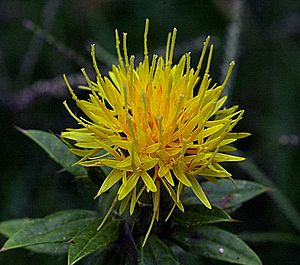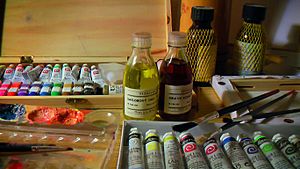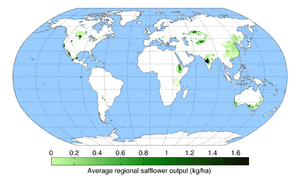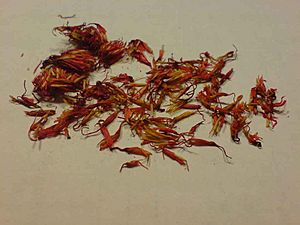Safflower facts for kids
Quick facts for kids Safflower |
|
|---|---|
 |
|
| Scientific classification | |
| Genus: |
Carthamus
|
| Species: |
tinctorium
|
Safflower, also known as Carthamus tinctorius, is a plant that looks a bit like a thistle. It's an annual plant, which means it grows and dies within one year. People grow safflower mainly to get vegetable oil from its seeds. Long ago, in Spanish colonies along the Rio Grande, it was used instead of saffron for coloring food.
Safflower plants can grow from about 30 to 150 centimeters (1 to 5 feet) tall. They have round flower heads that can be yellow, orange, or red. Each branch usually has one to five flower heads, and each head holds about 15 to 20 seeds. Safflower naturally grows in dry places that have rainy seasons. It has a long taproot that helps it find water deep in the ground, so it can grow well in these dry areas.
Contents
Safflower's Long History
Safflower is one of the oldest crops grown by humans. It was first farmed in Mesopotamia, which is a very old region in the Middle East. Some signs suggest it was grown as early as 2500 BC!
People in ancient Egypt used dyes made from safflower for their clothes around 1991–1802 BC. They even found garlands made of safflowers in the tomb of the famous pharaoh Tutankhamun. In ancient Greece, the name for safflower, kārthamos, appeared many times on old tablets. They talked about two kinds: white safflower and red safflower. This is because both the pale seeds and the red flowers of the plant could be used.
The early Spanish settlers in New Mexico, along the Rio Grande, used safflower as a cheaper way to get the color and flavor of saffron for their traditional recipes. There's even a special type of safflower from Corrales, New Mexico, called "Corrales Azafran," which is still grown today and used in New Mexican cuisine as a saffron substitute.
Where Safflower is Grown Today
In 2018, the world produced over 627,000 tonnes of safflower seeds. Kazakhstan was the biggest producer, growing 34% of the world's total. The United States and India together produced another 26% of the world's safflower.
How Safflower is Used
For a long time, safflower was grown for its seeds. It was used to color and flavor foods, in medicines, and to make red and yellow dyes. This was especially true before cheaper artificial dyes became available.
Safflower Oil for Cooking and More
For the past 50 years, safflower has been grown mostly for the vegetable oil that comes from its seeds. Safflower seed oil doesn't have much flavor or color, and it's similar to sunflower oil in terms of nutrition. It's often used in cosmetics and as a cooking oil. You might find it in salad dressings or used to make margarine.
There are two main types of safflower oil. One type has a lot of oleic acid, which is a monounsaturated fat. The other type has a lot of linoleic acid, which is a polyunsaturated fat. Today, the type with more oleic acid is more popular for cooking because it has less saturated fats than olive oil. The other type, with more linoleic acid, is sometimes used in painting instead of linseed oil. It's especially good for white paints because it doesn't have the yellow tint that linseed oil can have.
Some studies have shown that eating safflower oil can help lower levels of "bad" low-density lipoprotein (LDL) cholesterol in the blood. High LDL levels can be a risk factor for cardiovascular diseases.
Safflower Flowers in Food
Safflower flowers are sometimes used in cooking as a less expensive replacement for saffron. Because of this, it's sometimes called "bastard saffron."
The dried petals of the safflower plant can also be used to make a type of herbal tea.
Dye from Safflower Flowers

Dried safflower flowers are a natural source for a bright orange-red color called carthamin. This pigment is used to color textiles and is also known as Carthamus Red or Natural Red 26 in the dye industry.
In Japan, people have become very skilled at making a bright red to orange-red dye from dried safflower flowers. To get darker shades, they dye the fabric several times, letting it dry in between each dyeing step.
Safflower for Eco-Friendly Oils
In Australia, scientists have been working on using safflower to create a special oil that is 93% oleic acid. This oil is designed to be biodegradable, meaning it can break down naturally in the environment. It can be used in things like lubricants, hydraulic fluids, and transformer oils. It can also be a raw material for making other eco-friendly products like biopolymers.
Images for kids
See also
 In Spanish: Cártamo para niños
In Spanish: Cártamo para niños






